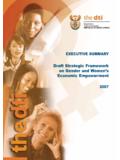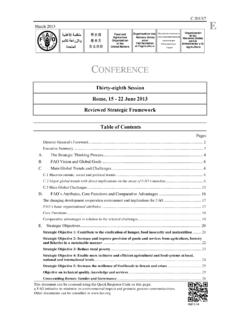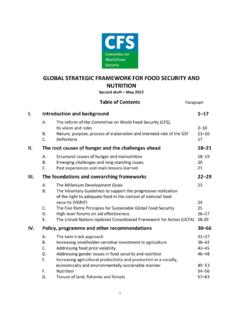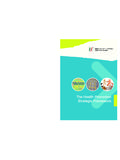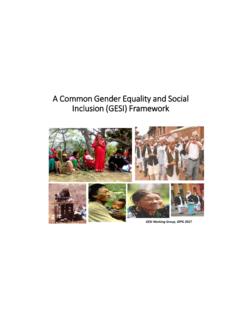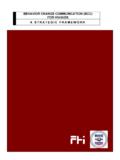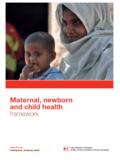Transcription of Water, Sanitation & Hygiene (WASH) Sector …
1 The Republic of South Sudan (RSS) Ministry of Water Resources & Irrigation (MWRI) Water, Sanitation & Hygiene ( wash ) Sector strategic framework Water for Life and Development, Sanitation and Hygiene for Healthy and Productive Citizens Augu st 20 11 TABLE OF CONTENTS FOREWORD .. i ACKNOWLEDGMENT ..ii LIST OF ACRONYMS .. iii EXECUTIVE SUMMARY .. vi 1. INTRODUCTION .. 1 Vision .. 1 Mission .. 1 Slogan .. 1 Context of the wash Sector strategic framework .. 1 Purpose and Scope .. 2 Rationale .. 2 Structure and Content .. 2 2. SOUTH SUDAN CONTEXT .. 3 Current Status and Challenges of the wash Sector .. 3 Existing Baseline Data for the wash Sector .
2 4 3. WATER RESOURCES MANAGEMENT SUB- Sector STRATEGY .. 6 Current Situation and Context .. 6 Goals and Objectives .. 7 strategic Approach .. 8 Assessment and Monitoring .. 8 Planning and Development .. 8 Regulation, Allocation and Use .. 9 Research and Innovation .. 9 Setting up WRM Institutions .. 10 Financing Water Resource Management .. 10 4. Sanitation AND Hygiene SUB-STECTOR STRATEGY .. 11 Current Situation and Context .. 11 Existing Legislation and Policies .. 12 Goals and Objectives .. 12 strategic Approach .. 12 strategic Components .. 14 Component 1: Enabling Environment .. 14 Component 2: Demand Creation .. 16 Component 3: Accelerated Supply of Services.
3 16 5. RURAL WATER SUPPLY SUB- Sector STRATEGY .. 17 Current Situation and Context .. 17 Existing Policies and Legislation .. 17 Goals and Objectives .. 17 strategic Approach .. 18 strategic Components .. 19 Component 1: Enabling Environment .. 19 Component 2: Sustained Services .. 20 Component 3: Accelerated Supply of Services .. 21 6. URBAN WATER SUPPLY SUB- Sector STRATEGY .. 23 Current Situation and Context .. 23 Goals and Objectives .. 24 strategic Approach .. 24 Technical Aspects .. 24 Operation and Maintenance .. 24 Cost-Recovery Financing and Targeted Investment .. 24 Governance and Institutional Aspects .. 25 Integrated Planning .. 25 7. wash Sector OVERALL GOVERNANCE AND DEVELOPMENT STRATEGY.
4 26 Institutional and Legal framework .. 26 Current Situation and Context .. 26 Goals and Objectives .. 27 strategic Approach .. 27 Information Management and 28 Current Situation and Context .. 28 Goals and Objectives .. 29 strategic Approach .. 29 Planning .. 29 Current Situation and Context .. 29 Goals and Objectives .. 31 strategic approach .. 31 Performance Monitoring .. 32 Current Situation and Context .. 32 Goals and Objectives .. 32 strategic approach .. 32 Financing and Investment .. 33 Current Situation and Context .. 33 Goals and Objectives .. 34 strategic Approach .. 34 Capacity Development .. 35 Current Situation and Context .. 35 Goals and Objective.
5 36 strategic approach .. 36 ANNEXES .. 37 Annex 1: Sector Governance and Regulatory framework .. 37 Annex 2: SSWSSC ToR .. 41 Annex 3: Glossary of Terms and Definitions .. 43 Annex 4: List of Main Contributors .. 53 Annex 5: References .. 55 iFOREWORD The Ministry of Water Resources and Irrigation (MWRI) is mandated to address all water related functions in collaboration with the States and Counties. MWRI leads development of policies, strategies, guidelines, regulations and standards; in addition to coordinating external support. Thus, MWRI is to ensure coordinated development and management of water resources on one the hand, and provision and sustainability of water and Sanitation services on the other.
6 In line with the decentralisation as provided for in the Interim Constitution of Southern Sudan (2005) at the time, MWRI led the development of a Water Sector Policy in a participatory manner that ensured inputs from various stakeholders. Approved in 2007, the Policy outlined how the Sector will evolve, including establishing a distinction to its broad sub-sectors, namely: Water Resources Management (WRM), Rural Water Supply and Sanitation (RWSS), and Urban Water Supply and Sanitation (UWSS). The Policy set out key priorities for water Sector development and linkages to the other sectors, and provided a basic framework to guide future detailed implementation strategies that would provide further clarity to the Sector entities.
7 Following approval of the Policy, MWRI, key Government Sector stakeholders and partners involved in water, Sanitation and Hygiene ( wash ), identified the need for distinct sub-strategies to be prepared, including Water Resources Management (WRM); Rural Water Supply (RWS); Urban Water Supply (UWS); Sanitation and Hygiene (S in addition to an institutional framework and an Investment Plan. The Republic of South Sudan (RSS) emerged from civil war that destroyed basic infrastructure, Government institutions and undermined service delivery. The Government of Southern Sudan (GoSS) at the time was established in October 2005 under such circumstances; and the Water Policy was developed to address this inheritance.)
8 The purpose of this strategic framework is to operationalize the Water Policy through effective and technically sound strategic approaches. It shall enable this young nation to establish water and Sanitation infrastructure and manage it in a sustainable manner for the delivery of wash services as public goods to its citizens within the timeframe up to 2015. It points out the key strategic areas that need to be tackled within specific sub-sectors as well as the whole Sector . It provides direction for the sub-sectors and the overall governance and development priorities, upon which the action and investment plans are to be developed. This strategic framework shall pave the way to move from ad-hoc interventions to well-planned and well-targeted development programmes, including aid modalities such as Programme Based Approaches (PBAs).
9 Hence, it shall guide the Sector towards achieving the MDGs and to contribute to the overall socio-economic development of South Sudan. With this strategic framework , MWRI, key RSS Sector stakeholders and partners have initiated an inclusive Sector wide governance and development process. It will enable them to: identify sources, mobilise resources for investment, address priority interventions, leading towards sustainable, equitable and publicly accountable response to water related public-health and livelihoods aspirations in South Sudan. Paul Mayom Akec Riak Minister, Ministry of Water Resources and Irrigation The Republic of South Sudan, Juba iiACKNOWLEDGMENT This wash Sector strategic framework is an outcome of a collective effort through a consultative process carried out across South Sudan by the Government and its Partners under guidance of the South Sudan Water Sector Steering Committee (SSWSSC).
10 Building on the Sector experiences as well as existing strategic planning documents and mechanisms in South Sudan, MWRI led a Sector -wide dialogue and engagement in developing this strategic framework . Major technical inputs were coordinated by the four sub- Sector task forces, through vertical and horizontal consultations. Hence, this document is a product of a myriad of wash stakeholders, partners, professionals and practitioners with varying mandate, expertise and affiliation (Annex ) With their different backgrounds, all of them contributed right from the identification of the strategic components, to the process design and the drafting of the document.










